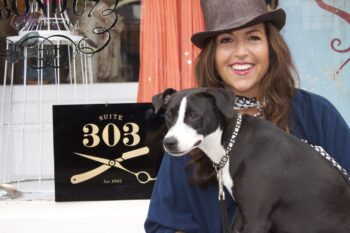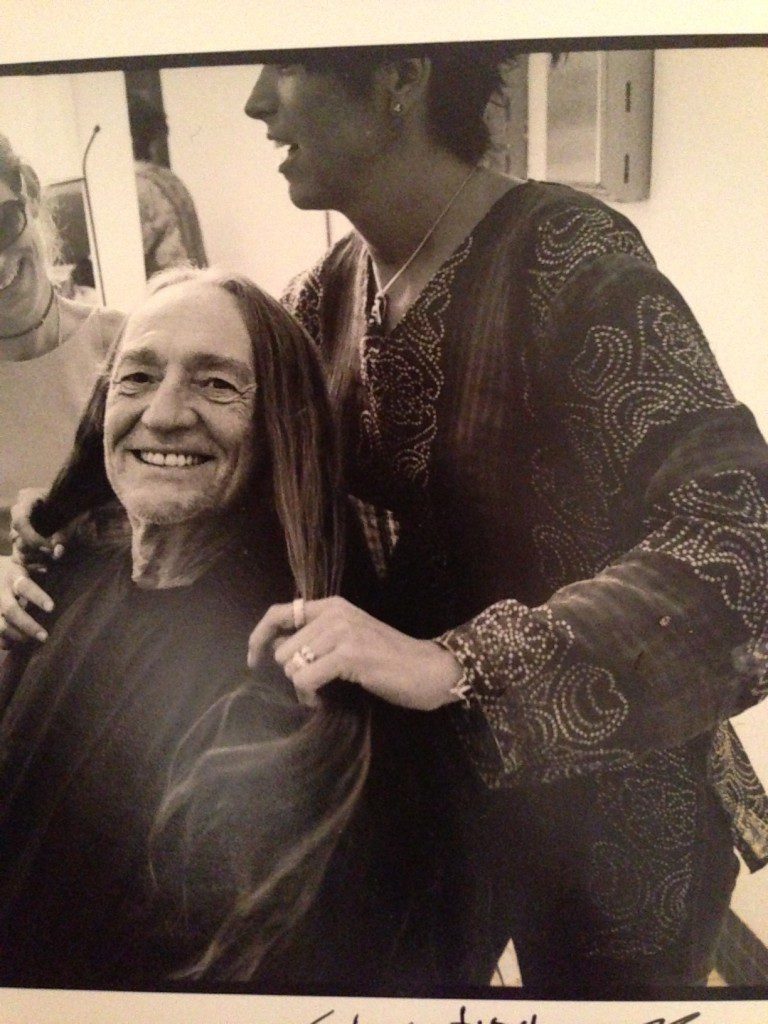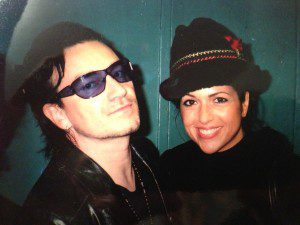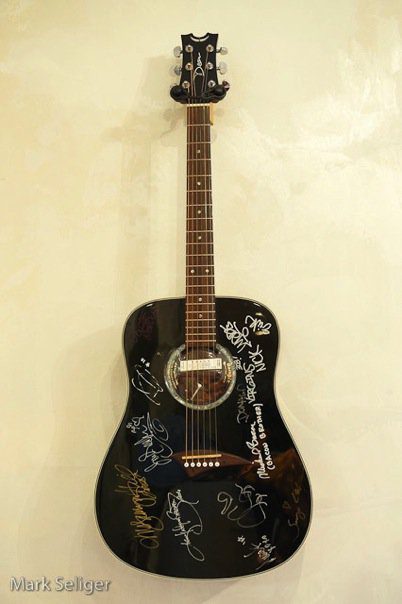
They say it’s a long way to the top if you wanna rock ‘n’ roll. In my case, the path led me from basement bands, to a gig as a writing professor, and then to public radio, where I’ve produced stories about music, from pre-teens rocking in the suburbs to the best Led Zeppelin tribute band this side of Kashmir.
I’m now pleased to present “Sound & Vision,” a new Rumpus profile series that spotlights the creative talents of those working behind the scenes in the music industry. Some are unsung. Others are rock stars in their own right. But in every case, what’s drawn me to their stories is how these folks have come to their work, and the unique wisdom and insight they’ve drawn from their experience.
First up is April Barton. Barton has styled covers for Rolling Stone and GQ, and appeared on Bravo’s Shear Genius and TLC’s 10 Years Younger. She’s the mastermind behind Willie Nelson’s famous braids, and her client roster is a who’s who of music’s biggest legends, including Bono, Elvis Costello, Mary J. Blige, and Bonnie Raitt.
Barton has come a long way from the small town in South Florida where she got her start at fifteen, styling her high school classmates. By eighteen, she was ready to break out, landing in London’s punk scene, and then on to New York where she quickly made a name for herself at the city’s top salons. Despite her early success, Barton felt creatively hemmed in, and after much soul-searching she decided to chuck it all and start over again. And that’s where true kismet came into play.
Upon returning from a six-week spiritual retreat, Barton was invited to a cocktail party thrown at the Chelsea Hotel by resident artist George Chemeche. He enchanted her with tales of the Chelsea’s storied history, and when Barton shared her vision of building a hair salon where musicians and artists could nurture each other’s creative spirits, Chemeche introduced her to the Chelsea’s managers and part-owners, Stanley and David Bard.
As soon as Barton saw Suite 303, which was, at the time, a simple corner hotel room, she knew she’d found the right home. She thrived in the space for eighteen years, styling musicians and scores of artists including Rene Ricard, Lola Schnabel, Leo Villareal, and Matthew Ritchie, who often bartered their time for time, and their art for art.
This past September, Barton relocated Suite 303 to its new location in Noho. When we recently met there, she reflected on where she’s been and where she wants to go next.
***
The Rumpus: You’ve styled some of the industry’s biggest stars. Who were some of your early style icons?
April Barton: Madonna was huge for me. When I was a freshman or sophomore in high school and Lucky Star came out and I saw this girl in fishnet stockings and bleached blonde hair and roots and bows, I just had so much identification with her rebellion. In South Florida, nobody wore wool to-the-floor trench coats. The snowbirds had sold or pawned them off to thrift stores and I would go and buy them and I would have teddies on underneath. And teachers used to send me to the office saying, you know, “she won’t take off her jacket,” and then I was like, Okay, I’m going to call their bluff. Next time they tell me to take off my jacket. And I’d have a teddy on and I’d get expelled for indecent exposure!
Rumpus: Tell me a little more about your high school. Is that where you first got involved with styling?
 Barton: I’d been on the run with my father, who was a gambler, and we had lived a very fast-paced lifestyle. And at fifteen I needed to settle down a little, so I rekindled with my mother, and I thought, Let me try to go out there and graduate high school with some stability. The high school was conventional. I mean it was out west, in Davie, Florida. And I would take kids home from school—like cheerleaders—I would befriend one or two of them and I noticed that all of them had really long hair, so I would take one home and chop off her hair and realize what a stir it created. The mother would call my house, and talk to my mom: “Your kid cut my daughter’s hair off!”
Barton: I’d been on the run with my father, who was a gambler, and we had lived a very fast-paced lifestyle. And at fifteen I needed to settle down a little, so I rekindled with my mother, and I thought, Let me try to go out there and graduate high school with some stability. The high school was conventional. I mean it was out west, in Davie, Florida. And I would take kids home from school—like cheerleaders—I would befriend one or two of them and I noticed that all of them had really long hair, so I would take one home and chop off her hair and realize what a stir it created. The mother would call my house, and talk to my mom: “Your kid cut my daughter’s hair off!”
I started learning the power of it early on—the power of image—of how you can set yourself apart. I started producing photo shoots and working in a cosmetic shop, and I would take people to thrift stores and dress them in fishnets… I started a portfolio, I took pictures of the girls, I did their makeup, I did their hair, I dressed them, and I had a very successful business by like sixteen years old and it just never stopped.
Rumpus: When and how did you break out of Florida?
Barton: I started working for Vito the barber—I became the assistant—and then I met this guy Richard Crowl, who had a salon called Twisted Scissors. He was super-talented, and he just opened up my world. And then at eighteen, I left Florida and went to open a school of hairdressing in England with these British dudes that I met. They had come into Miami to do these huge hair shows, and they would charge like $600 for a weekend seminar. And I was in beauty school at the time getting my license, and I met them in the parking lot and I was like, “I bet you didn’t take an assistant. I’m the best assistant there is!” I would walk in with them and grab their bags, and they ended up sending me a ticket to open up their school of hairdressing in London at the height of the punk scene in the late ‘80s, and that’s where I really became unleashed. For me, it was more the aesthetic and environment than the music. Like what we do here, in the States, you know the FDA and the regulations, and you know Caucasian dreads and hair falling off in the sink… Here you get sued; in London, it’s celebrated. Oh well, try it again! So it was this freedom of expression that was such a turn-on.
Rumpus: What brought you to New York?
Barton: I’d gone back to Florida but I knew it wasn’t going to work, and so I bought a one-way ticket. For me to come to New York City at nineteen, I had already been doing hair for like four or five years. I cornered people… like John Dellaria. They had a two-year assisting program. I was like, “You haven’t seen me cut hair.” They go, “Doesn’t matter. You don’t have any clientele. You go through the ropes just like everybody else.” So I was like, “Okay, on my days off, can I bring in clients?” And I would literally pay people to get their hair cut by me. I would cocktail at night and make $200-$300 and go out on West Broadway and buy like six or seven haircuts!
Rumpus: How did you choose people?
Barton: Whatever inspired me. I would just see people walk by and I would look at her and go, God! That would be amazing if I cut it to her collarbone! She looks like a giraffe! I could totally pop her cheekbones! Or I would look at somebody else and be like, I could totally do bed head style! I could rough it up! He looks like he’s probably a cool musician! He doesn’t want to get his hair cut because he’s scared that he’s going to get this stupid haircut on his head, but I can get in there and do what he would do if only he knew how! I would have these conversations with myself. The hair talks to me.
Rumpus: And at what point did you decide to go out on your own?
 Barton: Working for John Dellaria was stimulating. I still picture him to be a major influence in my development. He’s like a “hair father” to me. He taught me techniques. He celebrated my cutting. He encouraged my talent and my hands, so it really exploded.
Barton: Working for John Dellaria was stimulating. I still picture him to be a major influence in my development. He’s like a “hair father” to me. He taught me techniques. He celebrated my cutting. He encouraged my talent and my hands, so it really exploded.
I got booked solid on West Broadway in the ‘90s. But by the time people are asking for a certain cut, I’m usually over it. I’m onto the next. And John Dellaria was that type of a place. You get a lot of trendy people coming in and wanting something, and it started to kill me inside because I was like, This isn’t what I want to do. A good way of explaining the art of what I do—usually it’s an organic feeling about hair. Like, before the faux hawk came in, I was sort of thinking about Roman hats and the punk scene in the ‘80s, and by the time it’s mainstream, I’ve already been doing it for a year and I want to change my pace.
Rumpus: So I understand you left and started working with a lot of runway models, but you also felt pigeonholed in that environment—to such an extent that you seriously considered leaving the profession. What brought you back?
Barton: I went away on a spiritual retreat, sort of like Eat, Pray, Love. I took off and went to Indonesia and Australia and traveled on my own for six weeks. I ended up picking up scissors in Indonesia with little kids at bodegas, and not even knowing the language, and expressing myself like I did when I was fifteen. And the training and the technique and all the things I thought I wanted were really stripped away and there was nothing but a little cute smiling face and a pair of scissors and it went back to the essence of that power and the unique pull that it had. When I came back, the phone started ringing—“April where are you? I need a cut!”
Rumpus: And how did that lead you to Suite 303?
Barton: [In 1995] I ended up going to this cocktail party at the Chelsea Hotel at George Chemeche’s—he’s an amazing artist who’s been living at the Chelsea for like fifty years, and he turned me on to the culture of the hotel and about how it originated. And it was very decadent—unlike it’s been more recently. You know, they named all of Chelsea after the Chelsea Hotel and it had this amazing lush history. He got my story and he said, “So what are you going to do?” And I said, “I don’t know.” And he said, “I think you should meet the owners of the Chelsea, Stanley and David Bard.” And I said, “Oh my god, that sounds incredible!” because I didn’t want to open a ground-level salon—like what—April’s Cuttery? Then David showed me Suite 303.
Rumpus: Can you describe the space when you first saw it?
Barton: It had a twisted light fixture hanging in the middle room. It was dark. It had stucco walls and wobbly wooden floors and a dingy single bed pushed in the living room, a long hallway with a kitchen in it, and a back bedroom. And I walked in, and he was talking, and I asked, “Can I ask you not to say anything? I just want to feel the space.” And when I walked down that corridor I heard people laughing and I saw a lot of people there and I went out on the balcony, and I stood there and I smiled. And I looked back at him and said, “It’s mine. I’ll take it.” I had no idea what I was signing on to, didn’t know what the rent was going to be, never had a rent that high, didn’t have the money, didn’t know how I was going to pay it. But I signed the lease, moved in, and that was the beginning of a long, eighteen-year journey.
Rumpus: Do you remember the first cut you gave there?
Barton: The minute I stepped foot in there, my phone rang, and it was a girl saying, “I’ll go anywhere to have you cut my hair. Where are you now?” I pushed the bed over to the French door where the light was, I had her sit on the end of the bed, and I cut her hair. She gave me like eighty bucks or something, and I went to the corner store to buy cans of paint and painted the place a pale yellow, and my phone never stopped ringing. It blew up so quickly, everything I was looking for…musicians, models, actors… It was when I gave it all up and said, I’m just going to live my life here to the best of my ability and it feels right in this space and I can breathe here, that I could open the French door overlooking 23rd Street and go, Life is going to happen here! And it did.
Rumpus: A few months ago you decided to relocate the salon…
 Barton: Yes. The Chelsea Hotel and all the stories that go along with it were magical, but in the last two or three years the management changed and the owners decided to sell. I’d been sitting on the fence for a long time. So much of my identity was invested in the Chelsea Hotel because it gave me room to grow as an artist and cultivated who I am in the industry—you know, like “rock-and-roll hairstylist to the stars”—and it was organic and authentic, it was sort of something that came and gelled. I will be forever grateful for the time I spent at the Chelsea but it was time to say goodbye.
Barton: Yes. The Chelsea Hotel and all the stories that go along with it were magical, but in the last two or three years the management changed and the owners decided to sell. I’d been sitting on the fence for a long time. So much of my identity was invested in the Chelsea Hotel because it gave me room to grow as an artist and cultivated who I am in the industry—you know, like “rock-and-roll hairstylist to the stars”—and it was organic and authentic, it was sort of something that came and gelled. I will be forever grateful for the time I spent at the Chelsea but it was time to say goodbye.
I sent out a mass e-mail to all of my people, 3,000 people in the city, asking, Where do you see us? This woman, Selima [designer-optician Selima Salaun of Selima Optique], kept coming up, and the way people were speaking of her was the way I would want people to speak of me. When I heard she had a place on 7 Bond Street, my heart lit up, because there is no other place in the city where I could see Suite 303 at the Chelsea Hotel survive. I met Selima and I got chills—the cobblestone streets, the bohemian chic, the feeling of the Chelsea, I was like, Oh my god! I think it’s here! And sure enough it was.
Rumpus: What’s next for April Barton?
Barton: My goal now is to reinvent. Just when you think you know it all, and you’re on a thing, jack it. You know, I’m feeling now the new days of hair. I’m feeling like I want to make a statement. I want hair that speaks to you in the streets.
***
Hear Barton talk about how she got her start by clicking on the play button below. iPad/iPhone users click here.
[soundcloud url=”https://api.soundcloud.com/tracks/133567291?secret_token=s-sGUVT” params=”auto_play=false&hide_related=false&visual=true” width=”100%” height=”100″ iframe=”false” /]***
This interview has been edited and condensed. If you’d like to recommend someone for “Sound & Vision,” drop Allyson a line here.
***
Featured image, image of Willie Nelson with April Barton, and image of Bono with April Barton all courtesy of April Barton.
Image of April Barton’s guitar © by Mark Seliger.




